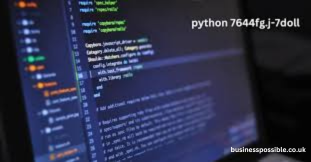Introduction to Python Identifiers
What are Python Identifiers?
In Python, identifiers are names used to identify variables, functions, classes, modules, and other objects. They are a fundamental part of coding as they provide a way to refer to data and functions within the code. Identifiers must start with a letter (a-z, A-Z) or an underscore (_) and can be followed by letters, numbers (0-9), or underscores.
Why are Identifiers Important?
Identifiers play a crucial role in code readability and functionality. They allow developers to create meaningful names for variables and functions, making the code more understandable and easier to maintain. Proper naming conventions help in avoiding confusion and errors during programming.
Decoding 7644FG.J-7Doll
Possible Interpretations of the Sequence
The sequence “7644FG.J-7Doll” does not follow typical Python naming conventions, which raises questions about its origin and purpose. Here are some possible interpretations:
- Code or Version Identifier: It could be a version number or code identifier related to a specific Python project or module.
- Unique Identifier: It might be a unique identifier used for tracking or referencing purposes within a system or database.
- Custom Naming: In some cases, developers use custom naming schemes for internal tracking or documentation.
Common Uses of Such Identifiers
Identifiers like “7644FG.J-7Doll” could be used in various contexts, such as:
- Project Versioning: To denote specific versions or builds of a software project.
- Database Entries: To uniquely identify records or entries in a database.
- Debugging: For tracking and managing different stages or elements of a development process.
Applications and Relevance in Python
Potential Applications of the Identifier
While “7644FG.J-7Doll” might not be a standard Python identifier, understanding its application can provide insights into its relevance. Possible applications could include:
- Software Versioning: In projects that require tracking different versions or iterations, unique identifiers help in managing and referencing specific builds.
- Data Management: Unique identifiers are often used in databases or data management systems to ensure accurate and efficient data retrieval.
How Python Handles Identifiers
Python does not inherently use complex identifiers like “7644FG.J-7Doll” but allows for flexible naming conventions within its syntax. Standard Python identifiers follow the rules of naming, and complex sequences might be employed in custom implementations or external systems interfacing with Python.
How to Handle Unfamiliar Identifiers
Best Practices for Understanding and Using Identifiers
- Research: Look up the identifier in relevant documentation or resources to understand its purpose.
- Consult Documentation: Review any project-specific or system-specific documentation that might explain the identifier’s use.
- Seek Expert Advice: If uncertain, consult with other developers or experts who might be familiar with the context.
Troubleshooting Issues Related to Identifiers
- Verify Source: Ensure that the identifier comes from a reliable source and is correctly implemented.
- Check Compatibility: Confirm that the identifier is compatible with the tools or systems you are using.
- Error Handling: Implement error handling to manage any issues arising from unfamiliar identifiers.
FAQs
1. What is a Python identifier?
A Python identifier is a name used to identify a variable, function, class, or other objects in Python code. It must start with a letter or underscore and can include letters, numbers, or underscores.
2. What does the sequence 7644FG.J-7Doll represent?
The sequence “7644FG.J-7Doll” could represent a code, version identifier, or unique reference within a specific project or system. Its exact meaning depends on the context in which it is used.
3. How can I find out more about a specific identifier?
To find out more about a specific identifier, check any available documentation related to the project or system where the identifier is used. Consulting with knowledgeable colleagues or experts can also provide clarity.
4. Can Python handle complex identifiers like 7644FG.J-7Doll?
While Python typically uses simpler naming conventions, complex identifiers can be employed in external systems or custom implementations interfacing with Python.
5. What should I do if I encounter an unfamiliar identifier in my code?
If you encounter an unfamiliar identifier, research its purpose, consult relevant documentation, and verify its use to ensure it is correctly implemented and understood.
Conclusion
The sequence “7644FG.J-7Doll” might not be a standard Python identifier, but understanding such sequences is crucial for managing and referencing elements within various systems and projects. By researching the context and purpose of these identifiers, developers can ensure accurate and effective use in their work. Whether dealing with versioning, data management, or custom implementations, clear understanding and proper handling of identifiers contribute to smooth and efficient development processes.
